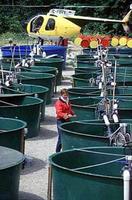Fish Hatcheries
FISH HATCHERIES are generally government- and community-run facilities intended to rebuild SALMON and TROUT populations and to conserve and rebuild threatened fish stocks. Hatcheries are also used to provide stock for the fish farming industry (see AQUACULTURE, FIN FISH).
In BC fresh waters, the earliest government hatchery efforts, dating back to the 1880s, primarily enhanced sockeye salmon at 17 hatcheries. This early program was discontinued in 1936, with the last hatchery closing in 1941. An enhancement program was re-established in the early 1960s with the use of spawning channels, expanding into hatchery technology. Initially the culture of salmon and trout was the responsibility of the federal government, but in 1938 responsibility for management of freshwater species was delegated to the province (see FISHERIES JURISDICTION). The provincial Ministry of Fisheries coordinates the inspection and licensing of all aquaculture sites, including hatcheries. The Ministry of Environment is responsible for management of freshwater fishes, including sea-going trout (cutthroat and STEELHEAD), within BC LAKES and streams and determines which areas are to be stocked with freshwater fish. The fish are then raised by the Freshwater Fisheries Society of BC (FFSBC), a non-profit society.
Many parts of BC have a long legacy of stocking. Some early stocking programs involved the use of exotic and non-native species, such as the brown trout. However, most fisheries agencies across N America now emphasize the culture of native stocks. To avoid ecological and genetic impacts on wild stocks, the provincial hatchery program is guided by a number of conservative policies. Stocking is only undertaken if it can be carried out without compromising wild stocks, or if there has been a previous history of stocking in a lake. The lakes chosen for stocking generally are closed systems—that is, they have no inflow or outflow streams—with little capability of sustaining a population of trout. The lake stock program is largely for "put-and-take" fisheries: fish are put in the lake so they can be taken out by sport fishers. The fish are not marked, and there is little or no "wild" component. In the mid-1990s, close to half of the freshwater angling effort in BC was on stocked lakes. The FFSBC operates 5 hatcheries and releases about 9 million fish annually into 1,000 lakes and streams.
Another form of hatchery rearing focusses on supplementation programs, in which hatchery fish supplement a naturally spawning population. The hatchery fish may be clipped for a hatchery-selective sport fishery; that is, adipose fins are removed to distinguish hatchery fish from wild fish. Fisheries and Oceans Canada (known as DFO after its former name, Department of Fisheries and Oceans), a federal agency, oversees salmonid hatcheries participating in the SALMONID ENHANCEMENT PROGRAM. Projects are operated by DFO staff or contracted to community and aboriginal groups, as well as by volunteers with some DFO support. As many as 10,000 volunteers participate in the program in any given year. A number of cutthroat and steelhead hatchery programs are administered jointly by DFO, MELP and the Ministry of Fisheries.
Yet another form of enhancement is known as Lake Enrichment (fertilization). These programs are designed to stimulate higher levels of food organisms and accelerate growth rates for the sockeye fry rearing in specific lakes. DFO also contributes financial and technical support to projects to improve and create freshwater spawning and rearing habitat throughout BC. See also FISHING, ABORIGINAL; FISHING, COMMERCIAL; FISHING, SPORT.
by Peter A. Robson

